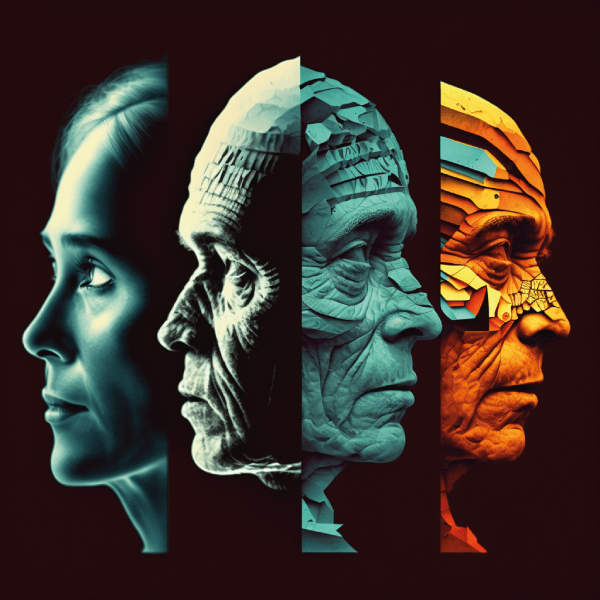In the grand tapestry of human existence, our consciousness has evolved significantly, shaping our perceptions, values, and interactions with the world around us. From primitive instincts geared toward survival to a more interconnected understanding of our place in the universe, our journey has been nothing short of remarkable.
Richard Barrett’s Seven Levels of Consciousness model offers profound insights into this evolution, shedding light on how it influences the creation of a sustainable world. Let’s embark on this enlightening exploration together.
The dawn of consciousness: clan awareness and tribe awareness
At the very roots of our consciousness lie clan awareness and tribe awareness. These initial stages find individuals primarily focused on belonging to a group and striving for personal success within that group. It’s akin to our primal instincts, the need for safety in numbers, and the drive to thrive within our respective tribes.
While these stages provide a sense of identity and purpose, they also come with their downsides. The intense group loyalty can inadvertently fuel tribalism, creating divides between different groups. As societies evolve, so does their consciousness, propelling them towards higher levels of awareness characterized by empathy, collaboration, and a profound sense of shared humanity.
Navigating the waters of state awareness and nation awareness
The next steps in our consciousness journey are state awareness and nation awareness. These stages revolve around the concept of law and order within a particular society or nation-state, as well as the welfare and development of that specific nation or global community.
While state and nation awareness can offer a sense of security and purpose, they also run the risk of nurturing conformity, nationalism, and exclusionary attitudes towards other nations. As individuals and societies progress, they ascend to higher levels of consciousness marked by greater creativity, innovation, and a deep-seated sense of shared global responsibility.
The pursuit of abundance: wealth awareness
Wealth awareness takes center stage in the evolution of consciousness, focusing on the creation of abundance and prosperity for oneself and others through entrepreneurship, innovation, and collaboration. This stage is where we actively seek personal and collective success, oftentimes measured by financial gain.
While it may provide a sense of achievement and satisfaction, it can also breed materialism and greed if not tempered with higher awareness. As individuals and societies advance, they can ascend beyond wealth awareness to embrace interconnectedness and a shared global responsibility for the well-being of all individuals and the planet as a whole.
The pinnacle of consciousness: people awareness and humanity awareness
In Richard Barrett’s Seven Levels of Consciousness model, the highest two levels are people awareness and humanity awareness. These stages revolve around the well-being and development of all individuals and the planet as a whole. They are characterized by compassion, empathy, social justice, and a commitment to positive social and environmental impact.
While these stages demand considerable personal commitment and the courage to challenge existing power structures and systems, they offer profound purpose, fulfillment, and a roadmap to a more sustainable and just world.
The significance of Barrett’s concepts
Barrett’s concepts hold immense importance in the quest for a more sustainable world. They provide a clear framework for understanding the intricate interplay between consciousness and behavior. By introspectively examining our values, beliefs, and assumptions, and by acting with greater consciousness and intentionality, we can collectively work towards creating a more just and sustainable society.
Fostering empathy and compassion
Empathy and compassion are the cornerstones of a sustainable world. By acknowledging our interconnectedness and prioritizing the well-being of all individuals and the planet, we set the stage for a more equitable world. It’s like recognizing that we’re all passengers on the same spaceship Earth, and it’s in our best interest to ensure its sustainability.
Collaboration: the heartbeat of progress
Collaboration is essential for creating a sustainable world. As individuals and societies ascend to higher levels of consciousness, they become more inclined towards collaboration and united in the pursuit of common goals. This synergy can unlock greater innovation, creativity, and problem-solving capacity. It’s like a well-choreographed dance where each partner plays a crucial role in the performance.
As we venture deeper into the realm of consciousness, our collaborative efforts become even more pronounced. It’s akin to a group of musicians improvising together, creating harmonious melodies that resonate far and wide.
Challenging existing power structures
To create a more sustainable world, we must challenge existing power structures and systems. These structures may serve as formidable barriers to progress, rooted in traditions that no longer serve our evolving consciousness. By cultivating higher levels of awareness, individuals and societies can defy these entrenched systems and work towards the creation of more equitable and just alternatives.
Think of it as breaking free from the constraints of an old, ill-fitting suit and donning one tailored to our evolving values and aspirations. It’s a humorous tug-of-war with the status quo, where consciousness emerges as the victorious rope-puller.
Promoting social and environmental responsibility
Barrett’s model underscores the importance of balancing financial success with social and environmental responsibility. It reminds us that prosperity should not come at the cost of our planet’s well-being or the welfare of our fellow humans. Prioritizing values such as sustainability, justice, and social responsibility allows individuals and organizations to wield their influence for positive social and environmental impact.
Picture a world where businesses prioritize sustainability, and individuals actively choose products that benefit both society and the environment.
Conclusion
In the grand narrative of human consciousness, Richard Barrett’s Seven Levels of Consciousness model shines as a guiding beacon. It illuminates the path towards higher consciousness characterized by empathy, collaboration, and social and environmental responsibility.
By embracing these values and acting upon them, individuals and societies can journey towards a more just and sustainable society that enriches the lives of all and nurtures our beloved planet.
So, let’s embark on this enlightening journey, together, towards a brighter, more conscious future.
FAQ
How can I personally evolve to higher levels of consciousness?
Elevating your consciousness is a deeply personal journey. Start by introspectively examining your values and beliefs. Embrace empathy and compassion in your daily interactions. Seek collaboration and challenge existing power structures when necessary.
Prioritize social and environmental responsibility in your choices and actions. It’s a gradual process that involves self-awareness and intentional growth.
Can societies collectively evolve to higher levels of consciousness?
Absolutely. Societal evolution is an amalgamation of individual growth and collective action. When a critical mass of individuals within a society embrace higher levels of consciousness, it can lead to transformative societal change.
Movements for social justice, environmental sustainability, and global cooperation are examples of collective efforts towards higher consciousness.
Are there real-world examples of societies or organizations embodying higher consciousness?
Yes, here are some real-world examples of societies and organizations that embody higher consciousness by prioritizing empathy, collaboration, social and environmental responsibility, and positive social impact:
- B Corporations (B Corps): B Corporations are for-profit companies that commit to meeting rigorous standards of social and environmental performance, accountability, and transparency. They consider the well-being of all stakeholders, including employees, customers, communities, and the environment, in their business practices. Patagonia, Ben & Jerry’s, and Danone North America are notable B Corps.
- Fair Trade Organizations: Fair Trade organizations focus on promoting equity and sustainability in global trade. They ensure fair wages and working conditions for producers in developing countries while encouraging sustainable farming practices. Fair Trade USA and Fair Trade International are key players in this movement.
- Social Enterprises: Social enterprises combine business strategies with a social or environmental mission. These organizations generate revenue while addressing societal challenges. TOMS Shoes, known for its “One for One” model, and Grameen Bank, a pioneer in microfinance, are prominent social enterprises.
- Eco-Friendly Companies: Many companies have adopted eco-friendly practices to reduce their environmental footprint. Examples include Tesla, which promotes electric vehicles to combat climate change, and The Body Shop, known for its commitment to cruelty-free and environmentally friendly products.
- The Transition Town Movement: This grassroots initiative encourages local communities to transition towards greater self-sufficiency and sustainability. Transition Town Totnes in the United Kingdom is a well-known example, focusing on local food production, renewable energy, and community resilience.
- Conscious Capitalism: Some businesses embrace the principles of conscious capitalism, which emphasizes purpose, stakeholder orientation, and conscious leadership. The Container Store and Whole Foods Market are often cited as examples of companies practicing conscious capitalism.
- Sustainable Cities: Certain cities around the world prioritize sustainability in urban planning and development. Copenhagen, Denmark, is renowned for its commitment to renewable energy and cycling infrastructure. Curitiba, Brazil, is celebrated for its innovative urban planning and public transportation system.
These real-world examples demonstrate that higher consciousness is not just a philosophical concept but a practical approach to creating a more equitable, sustainable, and just world through the actions of societies and organizations.



